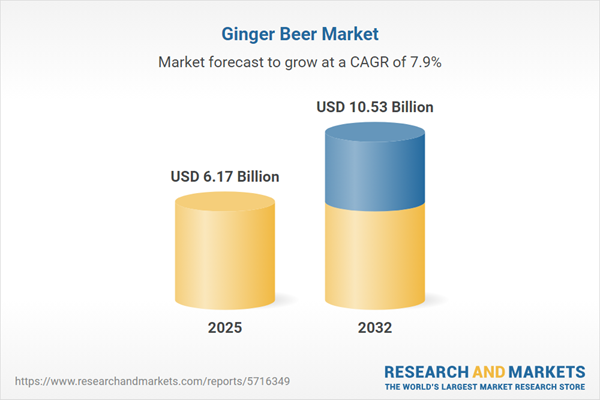Speak directly to the analyst to clarify any post sales queries you may have.
The ginger beer market is undergoing significant transformation amid changing consumer tastes, expanding distribution channels, and new regulatory dynamics. Senior decision-makers need accurate, actionable insights to adapt commercial strategies in this evolving landscape.
Market Snapshot: Growth Drivers and Market Value
The ginger beer market grew from USD 5.72 billion in 2024 to USD 6.17 billion in 2025. With a projected CAGR of 7.93%, the market is expected to reach USD 10.53 billion by 2032. Growth is fueled by product innovation, expanding digital retail platforms, and growing health-consciousness among consumers. These trends are further accelerated by shifting distribution strategies and heightened focus on product authenticity.
Scope & Segmentation
This report provides a comprehensive view across core industry segments and geographic regions, helping stakeholders identify opportunities for expansion and risk mitigation.
- Distribution Channels: Ecommerce (direct to consumer, marketplaces, online grocery), off-trade (convenience stores, specialist retailers, supermarkets), on-trade (bars, hotels, restaurants)
- Packaging Types: Glass bottle, PET bottle, can, keg
- Flavors: Fruit-infused (ginger lime, ginger orange, ginger peach), original, spiced
- Sugar Content: Low sugar, regular, zero sugar
- Price Tiers: Premium (brand/craft), standard, superpremium
- Organic Certification: Conventional, organic
- Regions: Americas (United States, Canada, Mexico, Brazil, Argentina, Chile, Colombia, Peru), Europe (United Kingdom, Germany, France, Russia, Italy, Spain, Netherlands, Sweden, Poland, Switzerland), Middle East (UAE, Saudi Arabia, Qatar, Turkey, Israel), Africa (South Africa, Nigeria, Egypt, Kenya), Asia-Pacific (China, India, Japan, Australia, South Korea, Indonesia, Thailand, Malaysia, Singapore, Taiwan)
- Key Companies: Fever-Tree Group PLC, Bundaberg Brewed Drinks Pty Ltd, Reed's, Inc., Gosling Brothers Limited, Fentimans Limited, Polar Beverages Corporation, Belvoir Fruit Farms Limited, East Imperial Co., Ltd., Thomas Henry GmbH, Q Mixers LLC
Key Takeaways for Ginger Beer Market Strategy
- Evolving consumer values are propelling demand for products emphasizing organic certification and low or zero sugar content.
- Premiumization, represented by both brand and craft releases, is contributing to enhanced differentiation and value creation across multiple regions.
- Digital-native brands are transforming the category by utilizing data analytics and subscription models to personalize offerings and respond rapidly to market trends.
- Collaborations with hospitality groups, unique flavor launches, and sustainability commitments are increasing brand affinity and competitive positioning.
- Segment expansion into fruit-infused varieties and eco-friendly packaging reflects consumer appetite for both novelty and environmental consciousness.
- Producers are leveraging multi-channel approaches to maximize consumer reach, bolster market penetration, and streamline inventory across both offline and online environments.
Tariff Impact: Navigating Regulatory and Supply Chain Dynamics
The introduction of United States tariffs in 2025 has introduced new pressures on imported ginger beer supply chains. Distributors are re-evaluating sourcing agreements, while domestic growers are forming strategic partnerships to ensure steady ingredient supply. Investment in alternative sourcing and negotiations around duty costs are key strategies being adopted to maintain profitability. Industry associations are actively engaging with regulatory bodies to seek exemptions for organic or small-batch producers. Retailers are optimizing promotions and loyalty programs to manage retail pricing and consumer accessibility.
Methodology & Data Sources
The report's findings are derived from primary interviews with supply chain participants and industry executives, consumer surveys exploring purchasing drivers, and detailed point-of-sale data analysis. Secondary research included reviews of trade literature, regulatory documentation, and retail audits. Statistical trend evaluation and scenario mapping provided a robust contextual foundation.
Why This Report Matters
- Enables leaders to benchmark strategies based on in-depth market segmentation, channel performance, and evolving consumer trends.
- Supports effective resource allocation for product innovation, supply chain adaptation, and regional expansion.
- Equips decision-makers with regulatory and sustainability insights to inform long-term planning and risk management.
Conclusion
Senior stakeholders will find this report a vital resource for navigating shifts in the ginger beer market. Informed strategy, resilient supply chains, and responsive product development are key to achieving sustained growth and differentiation.
Additional Product Information:
- Purchase of this report includes 1 year online access with quarterly updates.
- This report can be updated on request. Please contact our Customer Experience team using the Ask a Question widget on our website.
Table of Contents
3. Executive Summary
4. Market Overview
7. Cumulative Impact of Artificial Intelligence 2025
Companies Mentioned
The companies profiled in this Ginger Beer market report include:- Fever-Tree Group PLC
- Bundaberg Brewed Drinks Pty Ltd
- Reed's, Inc.
- Gosling Brothers Limited
- Fentimans Limited
- Polar Beverages Corporation
- Belvoir Fruit Farms Limited
- East Imperial Co., Ltd.
- Thomas Henry GmbH
- Q Mixers LLC
Table Information
| Report Attribute | Details |
|---|---|
| No. of Pages | 186 |
| Published | November 2025 |
| Forecast Period | 2025 - 2032 |
| Estimated Market Value ( USD | $ 6.17 Billion |
| Forecasted Market Value ( USD | $ 10.53 Billion |
| Compound Annual Growth Rate | 7.9% |
| Regions Covered | Global |
| No. of Companies Mentioned | 11 |









